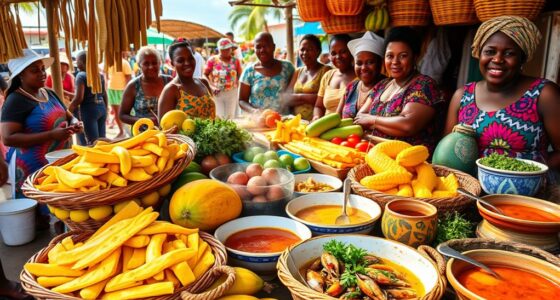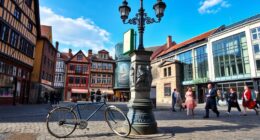St. Lucia’s history begins with indigenous Ciboney people whose legacy still influences the island today. European contact brought French and British rivalries, shaping its colonial past and sugar economy. Enslaved Africans resisted through revolts, crafting a vibrant culture of music, dance, and festivals like Carnival and Creole Day. The island shifted to independence in 1979 and now celebrates its diverse heritage through lively traditions and evolving industries. Explore further to uncover the rich stories behind its vibrant culture.
Key Takeaways
- Saint Lucia’s history includes indigenous Ciboney inhabitants, European colonization by France and Britain, and the legacy of slavery and emancipation.
- The island’s cultural heritage is rich with Creole language, traditional music like calypso and soca, and vibrant festivals such as Carnival and Creole Day.
- Colonial rivalries between France and Britain shaped Saint Lucia’s political evolution and diverse cultural influences.
- Post-sugar economy shifts have led to tourism growth, agricultural diversification, and eco-friendly development initiatives.
- Traditional expressions and festivals reflect Saint Lucia’s multicultural roots, fostering community identity and celebrating its history and heritage.
Early Indigenous Inhabitants and Their Legacy
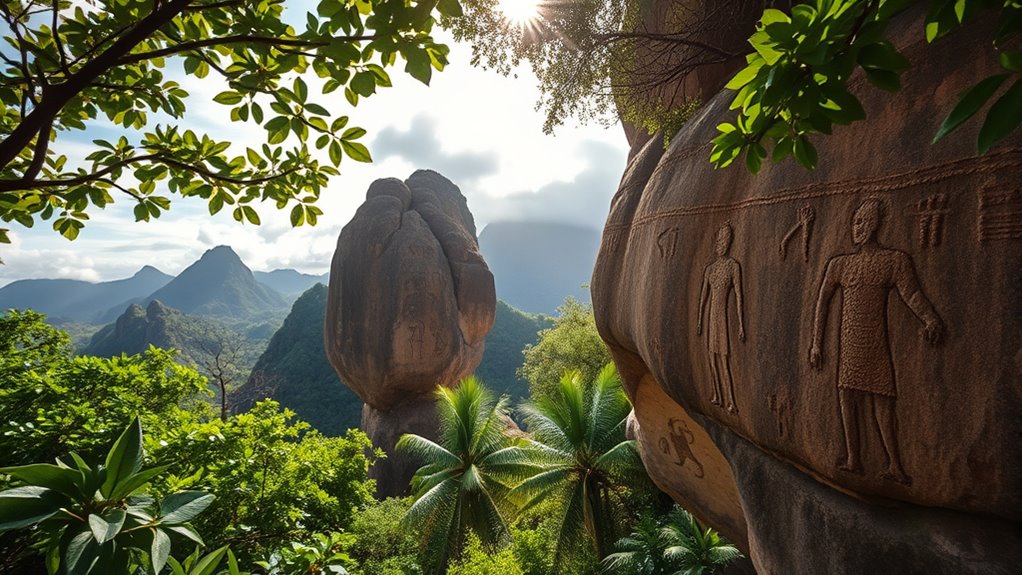
The earliest inhabitants of Saint Lucia were the Ciboney people, who settled on the island between 1000 and 500 BC. You can still find traces of their presence in archaeological sites, where tools and pottery reveal their way of life. They were hunter-gatherers, relying on the island’s forests and coastlines for sustenance. As you explore Saint Lucia today, you might notice clues of their existence in place names and local traditions. The Ciboney laid the foundation for later indigenous groups, influencing the island’s cultural heritage. Their legacy, though limited in physical remains, endures through stories, artifacts, and the recognition of Saint Lucia’s rich indigenous history. Understanding their role helps you appreciate the deep roots of the island’s cultural identity. Additionally, their artistic expressions provide valuable insights into their social and spiritual life.
European Contact and Initial Settlements

After centuries of indigenous presence shaping Saint Lucia’s early history, European explorers arrived, bringing new names, ambitions, and challenges. Christopher Columbus sighted the island in 1502, marking the start of European awareness. The early 1600s saw brief Dutch attempts to establish bases, but these failed due to Carib resistance. The French successfully settled on the island in 1650, naming it “Iouanalao” and “Hewanorra,” meaning “Island of the Iguanas.” Meanwhile, English efforts in 1605 and 1639 also faced strong Carib opposition, preventing lasting colonization. French control expanded with the development of sugar plantations from 1746, but it was contested repeatedly. These initial contacts set the stage for Saint Lucia’s complex colonial history, marked by shifting control and cultural influences. European colonization played a significant role in shaping the island’s diverse cultural heritage.
Colonial Rivalries Between France and Britain

Colonial rivalries between France and Britain shaped Saint Lucia’s history through a series of conflicts and shifting control. You see, both nations fought fiercely over the island during the 17th and 18th centuries, often changing hands multiple times. Treaties like Aix-la-Chapelle and the Peace of Versailles temporarily paused hostilities, but fighting resumed repeatedly. France expanded its settlements and developed sugar plantations from the mid-1700s, while the British also claimed the island at various points. It wasn’t until 1814 that Britain officially secured Saint Lucia as a crown colony under the Treaty of Paris. These rivalries left a lasting impact, influencing the island’s cultural landscape and laying the groundwork for future political developments. The ongoing colonial conflicts contributed to a diverse cultural heritage that persists today.
The Era of Slave Rebellions and Emancipation
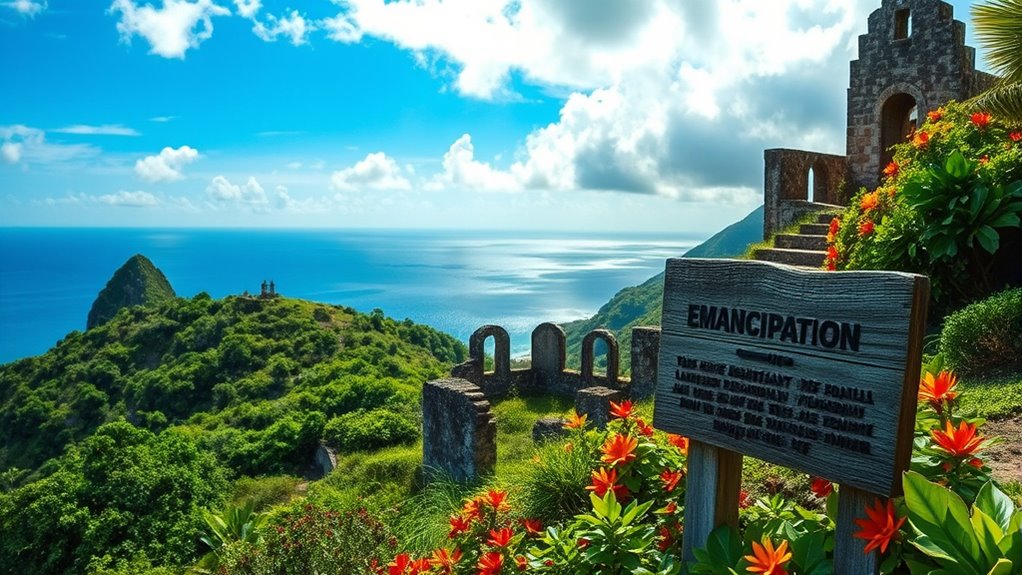
During the intense period of colonial rivalry between France and Britain, enslaved Africans on Saint Lucia began to resist their oppressors more openly. You would feel their courage as they fought back, inspired by revolutionary ideals. In 1795, Victor Hugues led a revolt that temporarily expelled British troops during “l’Année de la Liberté,” inspiring hope. Many slaves walked off plantations, demanding freedom, fueled by the French Revolution’s promises. When Britain regained control in 1803, many rebels fled into the rainforests, forming maroon communities. Emancipation in 1838 finally ended slavery, transforming the society. You can see their resilience and fight for dignity reflected in this table:
| Rebel Actions | Impact |
|---|---|
| Led revolts | Inspired hope |
| Fled into forests | Built maroon communities |
| Demanded freedom | Challenged colonial rule |
| Celebrated emancipation | Changed society |
| Remembered struggles | Shaped national identity |
Additionally, the enduring legacy of these resistance efforts continues to influence cultural identity on the island today.
Path to Self-Government and Political Evolution

The journey toward self-government in Saint Lucia began with the establishment of representative institutions in the early 20th century, marking a shift from colonial control to local political participation. You would witness the first elections in 1925, giving residents a voice in governance. Over the decades, political parties emerged, reflecting diverse views on development, independence, and social change. Universal suffrage in 1951 expanded voting rights, fueling political activism. Saint Lucia joined the West Indies Federation in 1958, aiming for regional unity, but dissolved in 1962, leading to increased autonomy. In 1967, the island became an Associated State, gradually gaining full independence in 1979. This peaceful progression involved key leaders like Sir John Compton, who shaped the nation’s political landscape and set the foundation for modern governance.
Saint Lucia’s Role in World War II
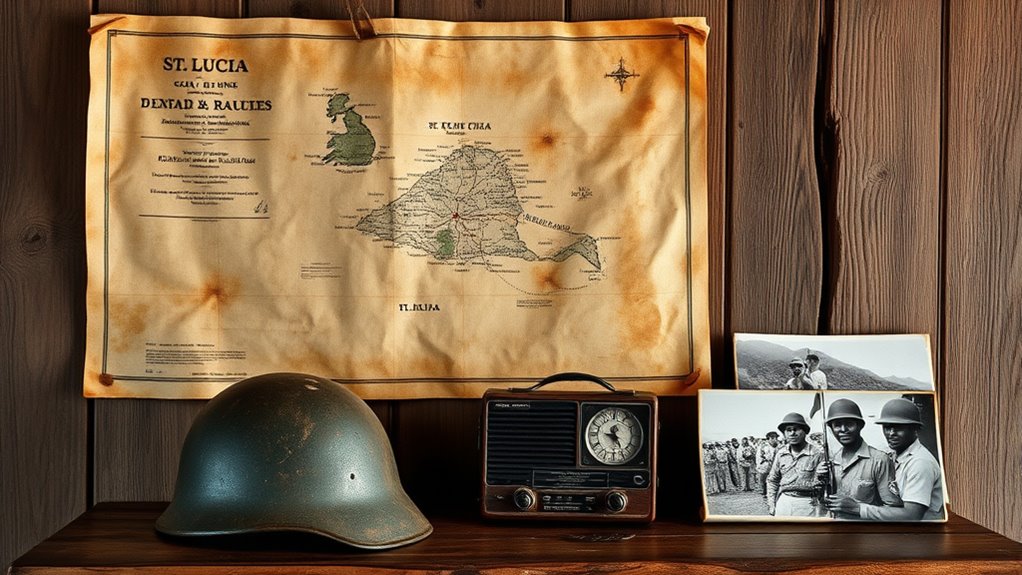
Saint Lucia’s strategic importance grew considerably during World War II, as the island became a crucial hub in the Caribbean theater of the conflict. You might not realize it, but the island hosted key military installations, including a U.S. naval base at Gros Islet and an air force base on what is now the international airport. These bases protected vital shipping lanes from German U-boat attacks and supported Allied operations across the Caribbean. In 1942, a German U-boat even attacked Castries harbor, highlighting the threat. The presence of U.S. troops and military infrastructure boosted local morale and spurred economic activity. Saint Lucia’s role in the war helped shape regional security cooperation and laid the groundwork for post-war development and international relations.
Cultural Influences and Heritage Foundations

You can see how Saint Lucia’s cultural influences stem from its indigenous Kalinago roots and its colonial history with France and Britain. These diverse origins shape the island’s vibrant expressions, from colorful festivals to unique Creole languages. Exploring these traditions reveals the deep heritage that continues to define Saint Lucia’s identity today. Additionally, onboard experiences like cultural cruises and local performances help visitors connect with the island’s rich history firsthand.
Indigenous and Colonial Roots
Indigenous peoples like the Kalinago, Arawaks, and earlier Ciboney shaped the island’s cultural foundations long before Europeans arrived. Their traditions, social structures, and spiritual beliefs laid the groundwork for Saint Lucia’s identity. When Europeans reached the island around 1500, they brought new influences, establishing colonies and altering the local landscape. French and British powers fought over the land, leaving a legacy of colonial rule that shaped language, governance, and social hierarchies. The mix of indigenous practices, African heritage from enslaved populations, and European customs created a unique cultural fabric. This layered history of conquest, resistance, and adaptation forms the core of Saint Lucia’s heritage, influencing its social fabric, traditions, and collective memory even today.
Cultural Expressions and Festivals
The rich cultural tapestry of Saint Lucia is vividly expressed through lively festivals, traditional music, dance, and language, all rooted in the island’s diverse heritage. You’ll experience vibrant celebrations like Carnival, which blends African rhythms, French influences, and Caribbean flair, creating an energetic atmosphere. Traditional music styles such as calypso, soca, and reggae echo through the streets, accompanied by colorful dance performances. Creole language and storytelling keep ancestral traditions alive, fostering a deep sense of identity. Festivals often feature:
- Carnival with elaborate costumes and parades
- The National Cultural Festival showcasing local art and music
- Lantern Festival celebrating Saint Lucia’s history and spirituality
- Creole Day honoring language, dance, and culinary heritage
These expressions connect you to the island’s rich roots and vibrant community spirit, much like how fan trailers serve as a creative platform that fosters community engagement and cultural exchange.
Economic Transitions and Modern Development
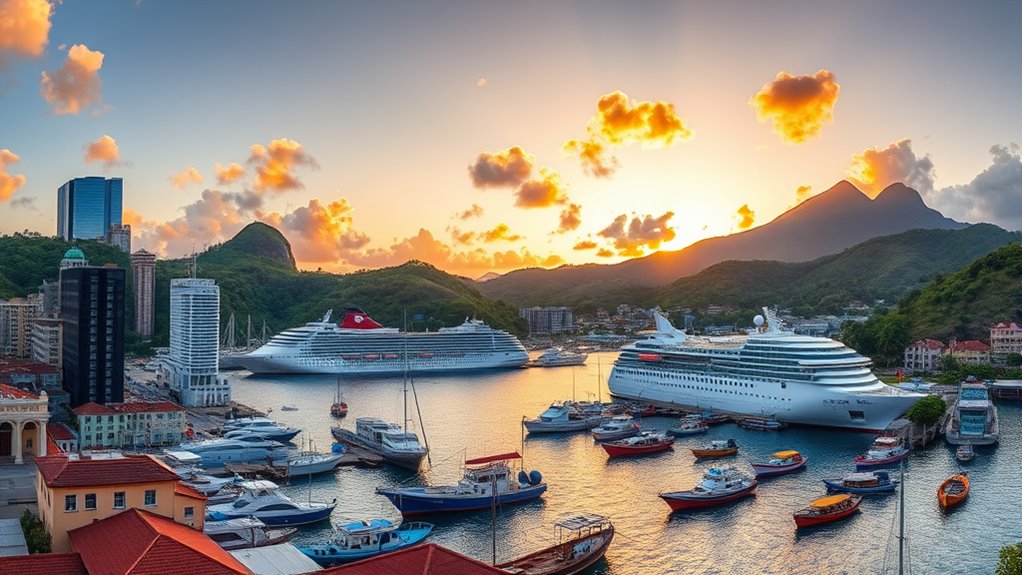
You’ll see how Saint Lucia shifted away from a reliance on sugar exports toward developing its tourism industry, which now drives much of the economy. As global markets changed, the island adopted diversification strategies to strengthen agriculture and reduce dependence on a single sector. These economic shifts have shaped modern Saint Lucia’s growth and resilience. Additionally, the country has invested in economic diversification initiatives to build a more sustainable and adaptable economy for the future.
Shift From Sugar Economy
Saint Lucia’s economy was historically driven by sugar plantations, which shaped its social and political landscape for centuries. As the global demand for sugar declined, the island began shifting toward diversification. You can see this change in the emergence of new industries and economic activities. Additionally, the influence of celebrity lifestyle insights on tourism development and marketing strategies has played a role in attracting visitors and boosting the economy.
- The decline of sugar led to the rise of tourism as a primary income source.
- Agriculture diversified to include bananas, cocoa, and other crops.
- Efforts to attract foreign investment grew, focusing on infrastructure and services.
- The government promoted small-scale entrepreneurship and local industries.
This progression reduced dependence on sugar, paving the way for a more resilient and varied economy. It also influenced social changes, fostering new opportunities and development avenues for the people of Saint Lucia.
Tourism Industry Growth
As the sugar industry declined, Saint Lucia increasingly turned to tourism to sustain its economy. You’ll notice how the island’s natural beauty—its beaches, rainforests, and volcanic peaks—became major attractions. Investments in infrastructure, like hotels and airports, boosted visitor numbers. Cruise ships regularly visit Castries, bringing in diverse tourists enthusiastic to experience the island’s vibrant culture and scenic landscapes. The government promoted eco-tourism and cultural festivals, highlighting Saint Lucia’s unique heritage. This shift created new employment opportunities and stimulated local businesses. Over time, tourism became a vital economic pillar, helping the island diversify its economy beyond agriculture. You’ll see modern developments, like luxury resorts and adventure tourism, reflecting Saint Lucia’s adaptation to a dynamic global market while preserving its cultural identity. Additionally, the use of Eye Patches in self-care routines reflects an increased focus on personal wellness amidst these modern developments.
Agricultural Diversification Strategies
To reduce its dependence on tourism and sugar exports, Saint Lucia has actively pursued agricultural diversification strategies. You can see efforts to boost food security and create new economic opportunities through this approach. The government supports farmers in adopting innovative crops and sustainable practices. They focus on reducing reliance on traditional sugar and banana industries while exploring new sectors. This shift helps build resilience against global market fluctuations. You might notice new farms experimenting with tropical fruits, vegetables, and herbs. Additionally, agro-processing industries are growing, adding value to local produce. The strategy aims to empower small farmers, stimulate rural communities, and promote environmentally friendly practices. This modern approach blends tradition with innovation, ensuring a more sustainable and diversified agricultural sector for Saint Lucia. Agricultural diversification is also supported by initiatives to introduce organic farming and eco-friendly methods, further strengthening the sector’s resilience.
Celebrating National Identity and Cultural Revival
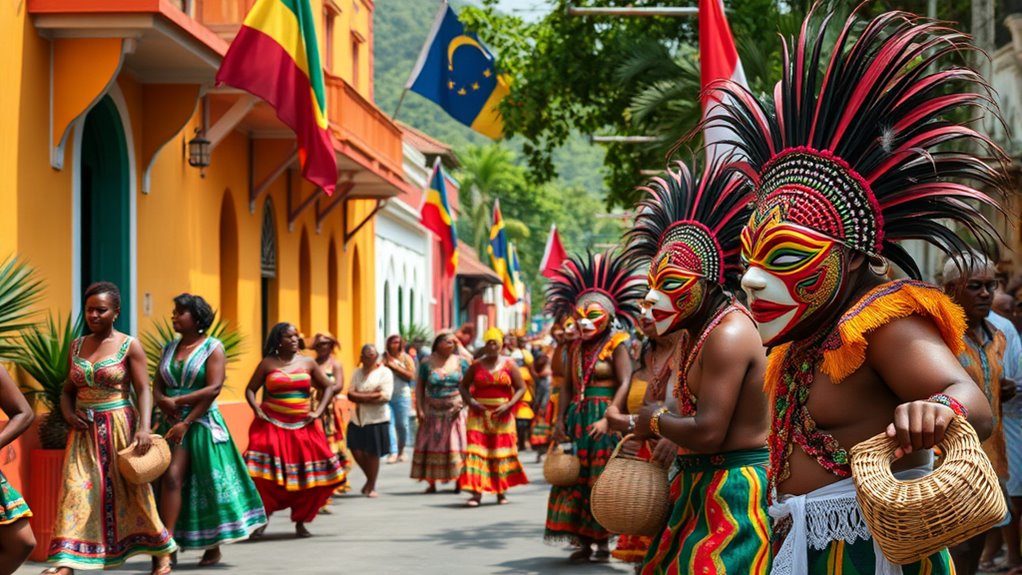
Celebrating national identity and cultural revival has become an essential expression of Saint Lucia’s resilience and pride. You participate in lively festivals, like Carnival and the Saint Lucia Jazz & Arts Festival, that showcase music, dance, and traditional costumes. These events honor indigenous roots, African heritage, and colonial history, reinforcing a shared sense of belonging. Education programs and cultural initiatives promote awareness of Saint Lucia’s unique history, while local artisans preserve traditional crafts. Through these efforts, you help strengthen the island’s identity and guarantee its vibrant culture endures. Here’s a visual overview:
| Cultural Celebrations | Heritage Preservation | Education & Outreach |
|---|---|---|
| Carnival & Jazz Fest | Craftsmanship & Art | School programs |
| Traditional dances | Cultural sites | Historical exhibits |
| Music & storytelling | Oral histories | Community events |
| National symbols | Museums & archives | Cultural workshops |
Frequently Asked Questions
How Did Indigenous Cultures Influence Modern Saint Lucian Society?
You can see indigenous cultures influence modern Saint Lucian society through language, festivals, and traditions. Creole languages blend African, European, and indigenous words, highlighting this heritage. Festivals celebrate indigenous roots, blending music, dance, and storytelling. You’ll also notice traditional crafts and practices kept alive in communities. These cultural elements foster a sense of identity, pride, and continuity, connecting current generations to their ancestors’ history and enriching the island’s vibrant cultural landscape.
What Specific Events Marked the End of Slavery in Saint Lucia?
You see that slavery in Saint Lucia officially ended in 1838 when emancipation was formally declared, freeing the enslaved population. Before that, a significant slave revolt led by Victor Hugues in 1795 temporarily expelled British control, demonstrating resistance. After emancipation, many former slaves fled into the rainforests to form maroon communities, fighting for freedom and shaping the island’s social fabric long-term.
How Did Colonial Rivalries Shape the Island’s Geopolitical Landscape?
You see that colonial rivalries between France and Britain deeply shaped Saint Lucia’s geopolitical landscape. These nations fought over control, switching hands 14 times, creating a patchwork of influence. You notice how these conflicts led to shifts in governance, culture, and infrastructure, leaving a legacy of diverse traditions. Their struggle for dominance also resulted in treaties and eventual British control in 1814, impacting the island’s development and identity for generations.
What Role Did Saint Lucia Play in Regional Caribbean Security?
You see, Saint Lucia has acted as a vigilant sentinel in Caribbean security, standing guard over crucial sea lanes. Its strategic location attracted military installations and naval bases, making it a key player in regional defense. During World War II, it served as a frontline point against threats like U-boats. Today, its role continues in regional cooperation, anchoring stability and ensuring the Caribbean remains a safe harbor for all.
How Is Saint Lucia’s Cultural Heritage Celebrated Today?
You celebrate Saint Lucia’s cultural heritage today through vibrant festivals like the annual Saint Lucia Carnival and Creole Day, which showcase local music, dance, and cuisine. You participate in traditional events that honor indigenous roots and colonial history, such as storytelling, craft markets, and historical reenactments. You also enjoy music genres like calypso and reggae, reflecting the island’s diverse influences, and support artisans who preserve traditional crafts and local artistry.
Conclusion
You embrace Saint Lucia’s rich history, its resilient spirit, and vibrant culture. You celebrate its indigenous roots, honor its colonial struggles, and cherish its journey toward independence. You recognize the influence of diverse traditions, the importance of unity, and the power of cultural revival. You connect with the island’s past, participate in its present, and shape its future. You are part of Saint Lucia’s ongoing story—its history, its culture, its identity.




